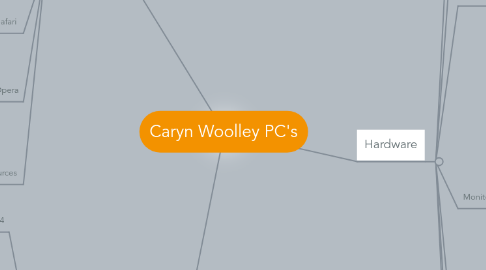
1. Browsers
1.1. Google
1.1.1. Legacy Version
1.1.2. Chrome
1.1.2.1. 16.20% of global market share
1.1.2.2. Increasing market share by .65% per month
1.1.2.3. Expected to overtake Mozilla Firefox for 2nd
1.1.2.4. Usable in Windows and Mac format
1.2. IE9
1.2.1. 54.39% market share globally
1.2.2. Comes installed on most PCs - Pushed by Microsoft
1.2.3. Not as agile in new HTML development
1.2.4. Lost 7.5% of market share in last calendar year
1.2.5. Not usable in Mac format
1.3. Mozilla Firefox
1.3.1. 22.48% of global market share
1.4. Safari
1.4.1. 6.45% of global market share and 13.47% in U.S.
1.4.2. Only used on Mac platforms
1.5. Opera
1.5.1. 1.67% of global market share
1.5.2. Cross compatible with Windows, Mac And Linux
1.5.3. Cloud compression
1.6. Sources
1.6.1. http://tinyurl.com/3w5abtl
1.6.2. http://tinyurl.com/3cb4au9
1.6.3. http://tinyurl.com/3w4vcun
2. PC Operating Systems
2.1. Ubuntu 11.04
2.1.1. Pros:
2.1.1.1. 1
2.1.1.1.1. Price - Open Source/Free
2.1.1.2. 2
2.1.1.2.1. Extremely usable Linux variant
2.1.2. Cons:
2.1.2.1. 1
2.1.2.1.1. Limited applications
2.1.2.2. 2
2.1.2.2.1. Gaming
2.2. Windows 7
2.2.1. Pros:
2.2.1.1. 1
2.2.1.1.1. Ubiquity
2.2.1.2. 2
2.2.1.2.1. Has achieved baseline stability
2.2.2. Cons:
2.2.2.1. 1
2.2.2.1.1. Price - The most expensive OS
2.2.2.2. 2
2.2.2.2.1. Security requirements
2.3. Mac OS X
2.3.1. Pros:
2.3.1.1. 1
2.3.1.1.1. Greatest usability
2.3.1.2. 2
2.3.1.2.1. Stability
2.3.2. Cons:
2.3.2.1. 1
2.3.2.1.1. Rigid
2.3.2.2. 2
2.3.2.2.1. Limited hardware/support
3. Hardware
3.1. Processor
3.1.1. Power
3.1.1.1. Intel
3.1.1.1.1. Offer best performance and highest prices
3.1.1.2. AMD
3.1.1.2.1. Offers similar performance at lower costs
3.1.1.2.2. Chips tend to run hotter
3.1.2. Portability
3.1.2.1. Intel
3.1.2.1.1. Atom
3.1.2.2. Apple
3.2. RAM
3.2.1. Standard Capacity
3.2.1.1. How much is provided
3.2.2. Maximum Capacity
3.2.2.1. How much can you add in the future
3.2.3. Speed
3.3. Hard Drive
3.3.1. Solid State
3.3.1.1. No moving parts/Not vibration sensitive
3.3.1.2. Draws only a few watts
3.3.1.3. Many times more expensive and capacity is lower at this time
3.3.1.4. Semi-conductor based medium
3.3.2. Hard Disk
3.3.2.1. Magnetic based medium
3.3.2.2. New research may see 18TB HDD in near future
3.3.2.3. 10GB to 2TB
3.4. Monitor
3.4.1. Connections
3.4.1.1. HDMI
3.4.1.2. VGA
3.4.1.3. DVI
3.4.1.4. USB Ports
3.4.2. Aspect Ratio
3.4.2.1. 16:9 becoming standard versus older 4:3 format
3.4.3. Power Consumption
3.4.3.1. 17 to 53 watts
3.4.4. Native Resolution
3.4.4.1. 1920/1080 Resolution becoming standard
3.5. Graphics Card
3.5.1. Intel
3.5.1.1. Low power
3.5.1.2. Low cost
3.5.2. ATI
3.5.2.1. Ultra high performance
3.5.2.2. Cutting Edge
3.5.2.3. Highest price
3.5.3. NVIDIA
3.5.3.1. Broad spectrum of choices
3.6. Peripherals
3.6.1. Helps determine value for overall price point
3.6.1.1. Webcamera
3.6.1.1.1. Is it available?
3.6.1.2. Speakers
3.6.1.2.1. Is it available?
3.6.1.3. Microphone
3.6.1.3.1. Is it available?
3.7. Sources
3.7.1. http://tinyurl.com/msxz9e
3.7.2. http://tinyurl.com/3dtyjgu
3.7.3. http://tinyurl.com/6g7thvd
3.7.4. http://tinyurl.com/5wggwhp
